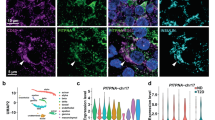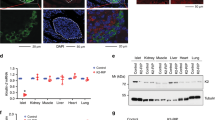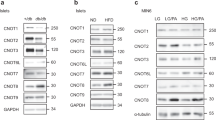Abstract
The total mass of islets of Langerhans is reduced in individuals with type 2 diabetes1, possibly contributing to the pathogenesis of this condition. Although the regulation of islet mass is complex, recent studies have suggested the importance of a signaling pathway that includes the insulin or insulin-like growth factor–1 receptors, insulin receptor substrate and phosphatidylinositol (PI) 3-kinase2,3,4. 3-Phosphoinositide–dependent protein kinase 1 (PDK1) is a serine-threonine kinase that mediates signaling downstream of PI 3-kinase. Here we show that mice that lack PDK1 specifically in pancreatic β cells (βPdk1−/− mice) develop progressive hyperglycemia as a result of a loss of islet mass. The mice show reductions in islet density as well as in the number and size of cells. Haploinsufficiency of the gene for the transcription factor Foxo1 resulted in a marked increase in the number, but not the size, of cells and resulted in the restoration of glucose homeostasis in βPdk1−/− mice. These results suggest that PDK1 is important in maintenance of pancreatic cell mass and glucose homeostasis.
This is a preview of subscription content, access via your institution
Access options
Subscribe to this journal
Receive 12 print issues and online access
$209.00 per year
only $17.42 per issue
Buy this article
- Purchase on Springer Link
- Instant access to full article PDF
Prices may be subject to local taxes which are calculated during checkout




Similar content being viewed by others
Accession codes
References
Butler, A.E. et al. β-Cell deficit and increased β-cell apoptosis in humans with type 2 diabetes. Diabetes 52, 102–110 (2003).
Kulkarni, R.N. et al. Tissue-specific knockout of the insulin receptor in pancreatic β cells creates an insulin secretory defect similar to that in type 2 diabetes. Cell 96, 329–339 (1999).
Withers, D.J. et al. Disruption of IRS-2 causes type 2 diabetes in mice. Nature 391, 900–904 (1998).
Kubota, N. et al. Disruption of insulin receptor substrate 2 causes type 2 diabetes because of liver insulin resistance and lack of compensatory β-cell hyperplasia. Diabetes 49, 1880–1889 (2000).
Cho, H. et al. Insulin resistance and a diabetes mellitus-like syndrome in mice lacking the protein kinase Akt2 (PKBβ). Science 292, 1728–1731 (2001).
Garofalo, R.S. et al. Severe diabetes, age-dependent loss of adipose tissue, and mild growth deficiency in mice lacking Akt2/PKBβ. J. Clin. Invest. 112, 197–208 (2003).
Pende, M. et al. Hypoinsulinemia, glucose intolerance and diminished β-cell size in S6K1-deficient mice. Nature 408, 994–997 (2000).
Alessi, D.R. et al. Characterization of a 3-phosphoinositide-dependent protein kinase which phosphorylates and activates protein kinase Bα. Curr. Biol. 7, 261–269 (1997).
Lawlor, M.A. et al. Essential role of PDK1 in regulating cell size and development in mice. EMBO J. 21, 3728–3738 (2002).
Accili, D. & Arden, K.C. FoxOs at the crossroads of cellular metabolism, differentiation, and transformation. Cell 117, 421–426 (2004).
Brunet, A. et al. Akt promotes cell survival by phosphorylating and inhibiting a forkhead transcription factor. Cell 96, 857–868 (1999).
Jefferies, H.B. et al. Rapamycin suppresses 5′TOP mRNA translation through inhibition of p70s6k. EMBO J. 16, 3693–3704 (1997).
Kitamura, T. et al. The forkhead transcription factor Foxo1 links insulin signaling to Pdx1 regulation of pancreatic β cell growth. J. Clin. Invest. 110, 1839–1847 (2002).
Uchida, T. et al. Deletion of Cdkn1b ameliorates hyperglycemia by maintaining compensatory hyperinsulinemia in diabetic mice. Nat. Med. 11, 175–182 (2005).
Stocker, H. & Hafen, E. Genetic control of cell size. Curr. Opin. Genet. Dev. 10, 529–535 (2000).
Kozma, S.C. & Thomas, G. Regulation of cell size in growth, development and human disease: PI3K, PKB and S6K. Bioessays 24, 65–71 (2002).
Easton, R.M. et al. Role for Akt3/protein kinase Bγ in attainment of normal brain size. Mol. Cell. Biol. 25, 1869–1878 (2005).
Mora, A. et al. Deficiency of PDK1 in cardiac muscle results in heart failure and increased sensitivity to hypoxia. EMBO J. 22, 4666–4676 (2003).
Lin, X. et al. Dysregulation of insulin receptor substrate 2 in β cells and brain causes obesity and diabetes. J. Clin. Invest. 114, 908–916 (2004).
Kubota, N. et al. Insulin receptor substrate 2 plays a crucial role in β cells and the hypothalamus. J. Clin. Invest. 114, 917–927 (2004).
Ueki, K. et al. Total insulin and IGF-I resistance in pancreatic beta cells causes overt diabetes. Nat. Genet. advance online publication 23 April 2006 (doi:10.1038/ng1787).
Inoue, H. et al. Role of hepatic STAT3 in brain insulin action on hepatic glucose production. Cell Metab. (in the press).
Herrera, P.L. Adult insulin- and glucagon-producing cells differentiate from two independent cell lineages. Development 127, 2317–2322 (2000).
Nakae, J. et al. Regulation of insulin action and pancreatic β-cell function by mutated alleles of the gene encoding forkhead transcription factor Foxo1. Nat. Genet. 32, 245–253 (2002).
Hashimoto, N. et al. PKCλ regulates glucose-induced insulin secretion through modulation of gene expression in pancreatic β cells. J. Clin. Invest. 115, 138–145 (2005).
Kido, Y. et al. Tissue-specific insulin resistance in mice with mutations in the insulin receptor, IRS-1, and IRS-2. J. Clin. Invest. 105, 199–205 (2000).
Shigeyoshi, Y. et al. Light-induced resetting of a mammalian circadian clock is associated with rapid induction of the mPer1 transcript. Cell 91, 1043–1053 (1997).
Ishihara, H. et al. Disruption of the WFS1 gene in mice causes progressive β-cell loss and impaired stimulus-secretion coupling in insulin secretion. Hum. Mol. Genet. 13, 1159–1170 (2004).
Acknowledgements
We thank T. Nakamura for discussion as well as M. Kawasaki and M. Nagano for technical assistance. This work was supported by grants for the Ministry of Education, Culture, Sports, Science, and Technology of Japan (MEXT) to M.K. and Y.K.; a grant from the 21st Century COE Program 'Center of excellence for signal transduction disease: diabetes mellitus as model' from MEXT to M.K.; a grant for the Cooperative Link of Unique Science and Technology for Economy Revitalization (CLUSTER) from MEXT to M.K.; a grant from Yamaguchi Endocrine Research Association to Y.K. and grants from the Juvenile Diabetes Research Foundation, the US National Institutes of Health and the Swiss National Science Foundation to P.L.H.
Author information
Authors and Affiliations
Corresponding author
Ethics declarations
Competing interests
The authors declare no competing financial interests.
Supplementary information
Supplementary Fig. 1
Lack of effect of β cell–specific ablation of PDK1 on the amount of PP cells. (PDF 161 kb)
Rights and permissions
About this article
Cite this article
Hashimoto, N., Kido, Y., Uchida, T. et al. Ablation of PDK1 in pancreatic β cells induces diabetes as a result of loss of β cell mass. Nat Genet 38, 589–593 (2006). https://doi.org/10.1038/ng1774
Received:
Accepted:
Published:
Issue Date:
DOI: https://doi.org/10.1038/ng1774
This article is cited by
-
Targeting pancreatic β cells for diabetes treatment
Nature Metabolism (2022)
-
Role of PDK1 in skeletal muscle hypertrophy induced by mechanical load
Scientific Reports (2021)
-
MiR-34b-3p Impaired HUVECs Viability and Migration via Targeting PDK1 in an In Vitro Model of Gestational Diabetes Mellitus
Biochemical Genetics (2021)
-
Multi-omics profiling reveals microRNA-mediated insulin signaling networks
BMC Bioinformatics (2020)
-
TarGo: network based target gene selection system for human disease related mouse models
Laboratory Animal Research (2019)



